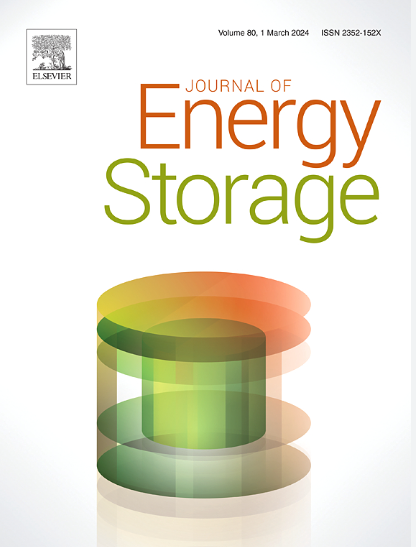2D nanoarchitecture-engineered polyetherimide dielectrics with thermally stable permittivity-breakdown dual enhancement
IF 8.9
2区 工程技术
Q1 ENERGY & FUELS
引用次数: 0
Abstract
To address the increasing demand for capacitive energy storage in high-temperature environments, the development of polymer dielectrics with high energy storage density, energy efficiency, and excellent thermal stability is critical. Here, ultra-low loadings (<0.5 wt%) of wide-bandgap (∼3.43 eV) two-dimensional CaBi2Nb2O9 (CBN) flakes are incorporated into a polyetherimide (PEI) polymer matrix. The addition of CBN flakes increases Young's modulus and bandgap of the nanocomposite, which helps to block the propagation of electrical trees, as indicated by the simulation results. This also suppresses carrier migration and effectively reduces high-temperature leakage current density, leading to a significant improvement in the breakdown strength and energy density of the CBN/PEI nanocomposites at high temperatures. For instance, the PEI nanocomposites with 0.3 wt% achieve an energy density of 3.24 J/cm3 with an efficiency (η) exceeding 90 % at 150 °C. Even at 200 °C, with η > 90 %, the discharge energy density remains as high as 2.22 J/cm3, which is 90 % higher than that of PEI. Notably, after 105 charge-discharge cycles, no degradation in energy density or efficiency is observed at elevated temperatures. This study presents a straightforward and broadly applicable strategy for developing high-temperature polymer dielectrics.
具有热稳定介电常数-击穿双重增强的二维纳米结构工程聚醚酰亚胺介电材料
为了解决高温环境下电容式储能日益增长的需求,开发具有高能量存储密度、高能效和优异热稳定性的聚合物电介质至关重要。在这里,超低负载(<0.5 wt%)的宽带隙(~ 3.43 eV)二维CaBi2Nb2O9 (CBN)薄片被掺入聚醚酰亚胺(PEI)聚合物基体中。模拟结果表明,CBN片的加入增加了纳米复合材料的杨氏模量和带隙,有助于阻止电树的传播。这也抑制了载流子迁移,有效降低了高温泄漏电流密度,导致CBN/PEI纳米复合材料在高温下击穿强度和能量密度显著提高。例如,添加0.3 wt%的PEI纳米复合材料在150°C时的能量密度为3.24 J/cm3,效率(η)超过90%。即使在200℃,η >;90%时,放电能量密度仍高达2.22 J/cm3,比PEI高90%。值得注意的是,在105次充放电循环后,在高温下没有观察到能量密度或效率的下降。本研究为高温聚合物电介质的开发提供了一种简单而广泛适用的策略。
本文章由计算机程序翻译,如有差异,请以英文原文为准。
求助全文
约1分钟内获得全文
求助全文
来源期刊

Journal of energy storage
Energy-Renewable Energy, Sustainability and the Environment
CiteScore
11.80
自引率
24.50%
发文量
2262
审稿时长
69 days
期刊介绍:
Journal of energy storage focusses on all aspects of energy storage, in particular systems integration, electric grid integration, modelling and analysis, novel energy storage technologies, sizing and management strategies, business models for operation of storage systems and energy storage developments worldwide.
 求助内容:
求助内容: 应助结果提醒方式:
应助结果提醒方式:


